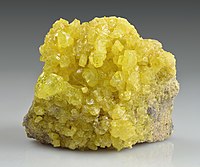
Photo from wikipedia
Abstract The interaction of gold cyanide complex with elemental sulphur and all metastable sulphur species has been studied using Density Functional Theory (DFT). The elemental sulphur and sulphide species formed… Click to show full abstract
Abstract The interaction of gold cyanide complex with elemental sulphur and all metastable sulphur species has been studied using Density Functional Theory (DFT). The elemental sulphur and sulphide species formed during pre-treatment of refractory gold ores or dissolution of sulphide minerals form a series of metastable species including hydrosulphide, polysulphide, thionates, sulphite and finally sulphates which are known to have a detrimental effect on gold cyanidation. Previous researchers have attributed this effect mainly to passivation of the gold surface. However, interaction of dissolved aurocyanide with sulphur species has received almost no attention. Here, DFT molecular modelling has been used for the first time to describe the interaction of dissolved gold cyanide and sulphur species, and to explain the reduction and destabilisation potential of sulphur species in gold cyanidation. Computational modelling shows that sulphur species can have a significant negative effect on the stability of gold cyanide complex. Elemental sulphur and sulphide ion with −446.6 and − 198.4 kJ.mol−1 interaction energies have the most negative effect. S0 and S2− contribute to the destabilisation of gold cyanide via two different mechanisms of precipitation of AuCN and thiocyanate formation as well as reduction of gold by formation of sulphite and sulphates respectively. The effect of elemental sulphur can be neutralised by excess free cyanide in solution, while sulphide ion can still stay reactive toward gold cyanide in the presence of free cyanide. Addition of lead salt can decrease the inhibiting effect of sulphide ions by formation of lead sulphide. However, lead cannot eliminate the negative effect of elemental sulphur. It is concluded that oxidation of sulphur species can significantly overcome the adverse impact of sulphur species on the stability of gold cyanide complex. The destabilisation of gold cyanide complex by sulphur metastable species is introduced as one of the main mechanisms for loss of gold in sulphide gold ores.
Journal Title: Hydrometallurgy
Year Published: 2020
Link to full text (if available)
Share on Social Media: Sign Up to like & get
recommendations!